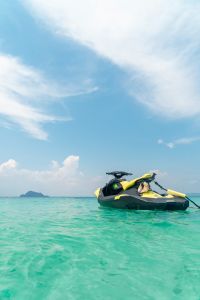- HOME
- > Blog Main Page
- > Arctic Cat Inc. v. Bombardier Recreational Products Inc.: What’s the Damage
Arctic Cat Inc. v. Bombardier Recreational Products Inc.: What’s the Damage
By Alexa Rose Colangelo
On February 19, 2020, the United States Court of Appeals for the Federal Circuit examined the appropriate amount of damages for patent infringement that occurs after the sale of unmarked products ceases but before an infringement suit is filed. In Arctic Cat Inc. v. Bombardier Recreational Products Inc., Arctic Cat brought an action against its competitor Bombardier for alleged patent infringement of Arctic Cat’s thrust steering system for personal watercrafts.[1] Arctic Cat licensed its patents for its thrust steering system for personal watercrafts to Honda in 2002, the licensing agreement for which expressly freed Honda of all marking obligations.[2] Honda proceeded to make and sell unmarked personal watercraft systems, and Arctic Cat failed to ensure that these personal watercraft systems were marked.[3] Arctic Cat claimed that Honda ceased selling unmarked personal watercraft systems in 2013, but Bombardier claimed Honda did not cease selling unmarked personal watercraft systems until 2018.[4] Arctic Cat sued Bombardier for patent infringement in 2014.[5] 
In order to determine the damages Arctic Cat could recover from Bombardier for patent infringement, the court looked to 35 U.S.C. § 287. According to 35 U.S.C. § 287, if a patentee fails to mark its patented article, it cannot recover damages for infringement unless the infringer was notified of the infringement and continued to infringe anyway.[6] In such a case, the patentee can recover damages only for the infringement that occurs after the infringer is notified.[7] This limitation on damages only applies to patentees making or selling unmarked patented articles.[8]
Because Arctic Cat’s licensing agreement with Honda explicitly freed Honda from all obligations to mark, Arctic Cat was responsible for complying with the notice requirement set forth in Section 287.[9] Because Arctic Cat did not provide any constructive or actual notice of infringement prior to filing an infringement suit against Bombardier, Arctic Cat was not entitled to recover damages for the period prior to filing suit.[10]
The fact that Honda ceased selling the unmarked personal watercraft systems did not free Arctic Cat from the notice requirement of Section 287. According to the court, Section 287 is not “temporally limited” and “prohibits a patentee from receiving any damages in a subsequent action for infringement after a failure to mark, rather than merely a reduced amount of damages in proportion to the amount of time the patentee was actually practicing the asserted patent.”[11] Once a patentee starts making or selling a patented product, the notice requirement under Section 287 is not satisfied until the patentee provides actual notice (charge of infringement) or constructive notice (marking its products).[12] The notice requirement does not simply vanish with the cessation of making or selling the unmarked product. Furthermore, the court rejected Arctic Cat’s argument that the finding of willful infringement by Bombardier was sufficient to establish notice because actual notice is determined by the conduct of the patentee rather than the knowledge of the infringer.[13]
The court’s decision in Arctic Cat highlights the underlying purpose of Section 287. In holding that Arctic Cat could not recover damages for infringement occurring after the sale of unmarked products ceased but before an infringement suit was filed against Bombardier, the court stressed that Section 287 is intended to “encourage marking, not merely discourage the sale of unmarked products.”[14] Arctic Cat’s failure to both reconcile noncompliance and provide notice cost it its pre-filing damages.
It is important to learn from Arctic Cat’s mistake and ensure that you mark your patented products so that you can reap the maximum amount of damages should infringement thereof be determined!
[1] Arctic Cat Inc. v. Bombardier Recreational Products Inc., 950 F.3d 860, 862 (Fed. Cir. 2020).
[2] Id.
[3] Id.
[4] Id.
[5] See id.
[6] See id. at 864.
[7] See id.
[8] See id.
[9] See id.
[10] See id.
[11] See id. at 865.
[12] See id. at 864-65.
[13] See id. at 866.
[14] See id. at 865.

TAGS:
RECENT POSTS
